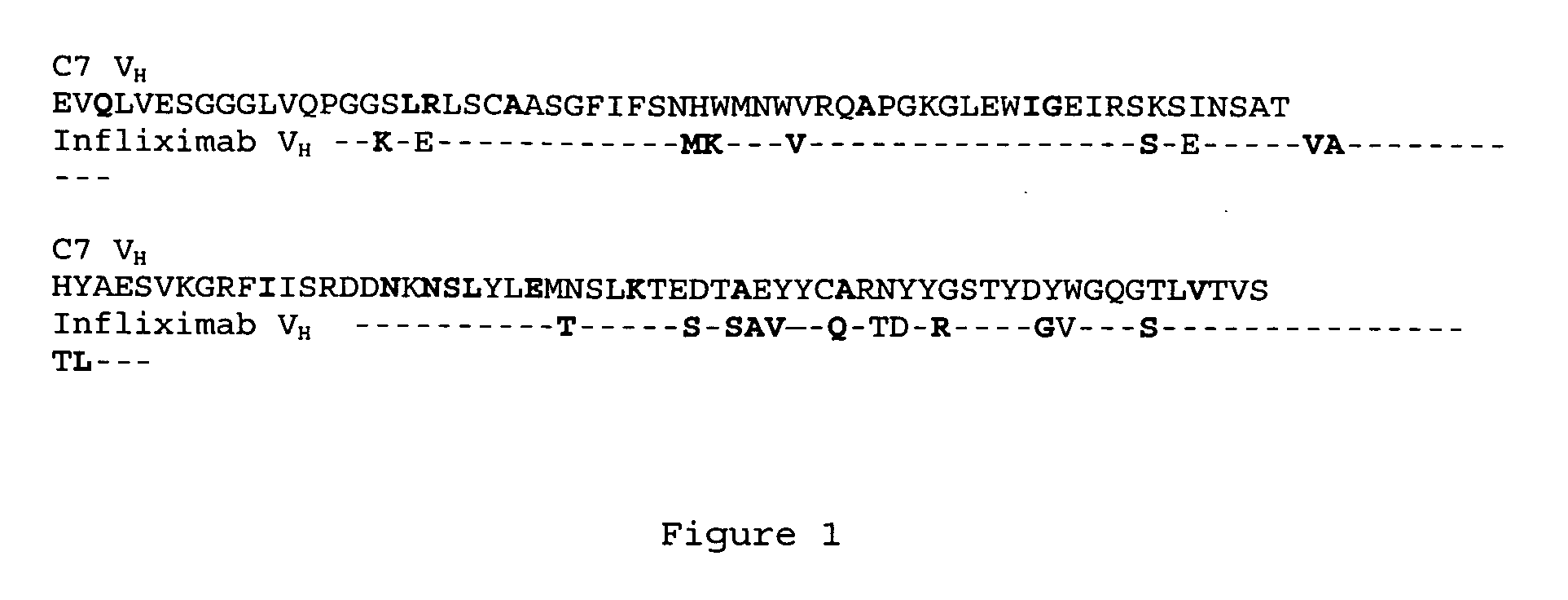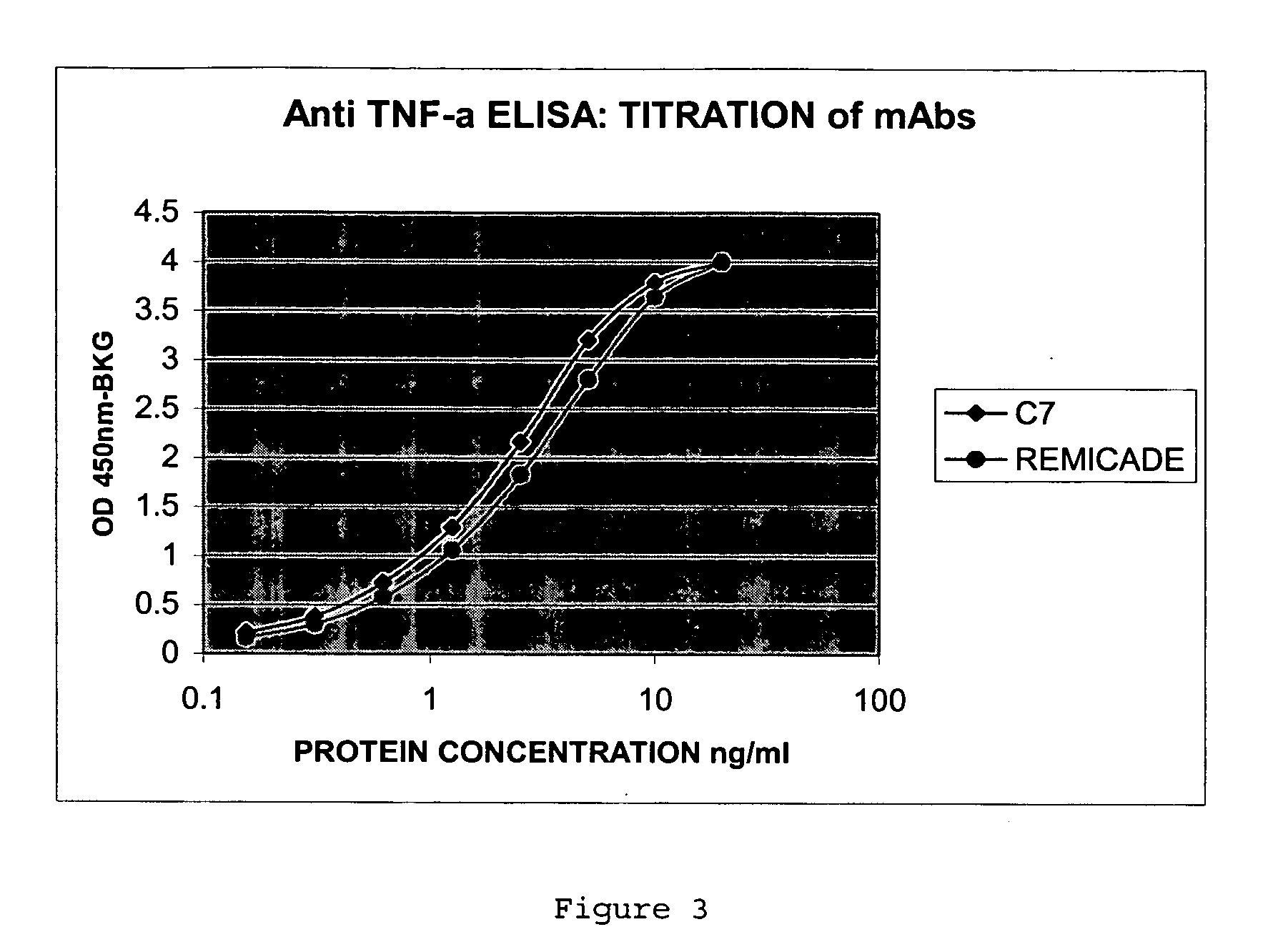Anti-TNFalpha antibodies and methods of use
a technology of anti-tnfalpha and antibodies, applied in the field of anti-tnfalpha antibodies, can solve the problem of limited therapeutic effect of a protein
- Summary
- Abstract
- Description
- Claims
- Application Information
AI Technical Summary
Benefits of technology
Problems solved by technology
Method used
Image
Examples
example 1
Generation of TNFα Antibodies
[0049] Fab libraries were designed based on a combination of infliximab sequence and structure-based criteria. The design goal was molecules with TNFα binding activity at least equal to that of infliximab with high similarity to human immunoglobulin sequences. For example, one criterion of selection for library members was sequence identity or similarity in framework and complementarity determining regions (CDRs) for both heavy and light chains with homologous human counterparts. The human immunoglobulin database at NCBI (ncbi.nlm.nih.gov) and the human germline immunoglobulin database (vbase.mrc-cpe.cam.ac.uk) were employed. Based on these criteria, VH polypeptides were designed with substitutions at one or a combination of 17 sites. These VH combinations were combined with one substituted VL polypeptide having an amino acid sequence shown in SEQ ID NO: 380 (encoding nucleic acid sequence shown in SEQ ID NO: 381). Synthetic Fab DNA libraries were gener...
example 2
Sequence Analysis of a TNFα Antibody
[0052] The framework portion of the VH region of one of the novel TNFα antibodies selected as described in Example 1 (C7) (SEQ ID NO: 3) is identical to human germline sequence (VH3 3-72 and JH4). As shown in FIG. 1, when compared to infliximab, 61 out of the 83 amino acids in the framework regions are identical. Of the 23 positions that are different, 14 of them (shown in bold) are conservative amino acid changes.
[0053] Similarly, the framework portion of C7 VL region is identical to human germline sequence (Vk1 A10 and Jk3). As shown in FIG. 2, when compared to infliximab, 63 out of the 80 amino acids in the framework regions are identical. Of the 17 positions that are different, 13 of them (shown in bold) are conservative amino acid changes.
example 3
Binding of Antibody C7 to TNFα
[0054] The full-length antibodies were used in a solid-phase ELISA binding assay as described in Example 1 to confirm the TNFα binding. FIG. 3 shows that the ELISA titration curve for C7 is comparable to that of infliximab.
[0055] C7 was also used in a Biacore assay to compare the binding constants of C7 and infliximab to TNFα. The results (not shown) indicated that the binding affinity of C7 to TNFα (KD=70 pM) is more than 2-fold higher than that of infliximab (KD=170 pM).
[0056] The present invention now being fully described, it will be apparent to one of ordinary skill in the art that many changes and modifications can be made thereto without departing from the spirit or scope of the appended claims.
PUM
 Login to View More
Login to View More Abstract
Description
Claims
Application Information
 Login to View More
Login to View More - R&D
- Intellectual Property
- Life Sciences
- Materials
- Tech Scout
- Unparalleled Data Quality
- Higher Quality Content
- 60% Fewer Hallucinations
Browse by: Latest US Patents, China's latest patents, Technical Efficacy Thesaurus, Application Domain, Technology Topic, Popular Technical Reports.
© 2025 PatSnap. All rights reserved.Legal|Privacy policy|Modern Slavery Act Transparency Statement|Sitemap|About US| Contact US: help@patsnap.com



